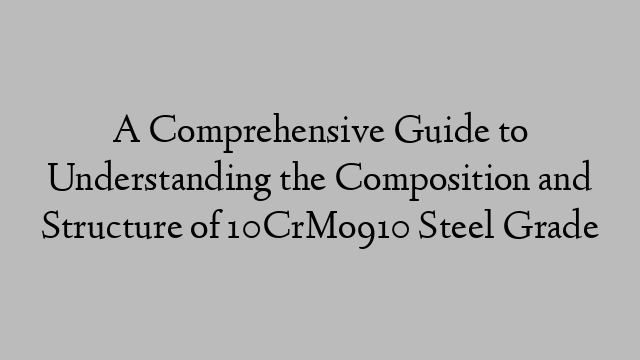Address
304 North Cardinal St.
Dorchester Center, MA 02124
Work Hours
Monday to Friday: 7AM - 7PM
Weekend: 10AM - 5PM
Address
304 North Cardinal St.
Dorchester Center, MA 02124
Work Hours
Monday to Friday: 7AM - 7PM
Weekend: 10AM - 5PM

A Comprehensive Guide to Understanding the Composition and Structure of 10CrMo910 Steel Grade
Introduction:
10CrMo910 is a high-quality, low-alloy steel grade commonly used in various industrial applications. It is known for its excellent heat resistance and mechanical properties, making it suitable for applications that involve high temperatures and pressures.
Chemical Composition:
The chemical composition of 10CrMo910 steel grade typically consists of the following elements:
– Carbon (C): The carbon content in 10CrMo910 is usually between 0.08% and 0.15%. Carbon provides hardness and strength to the steel.
– Manganese (Mn): The manganese content is usually kept low, ranging from 0.40% to 0.60%. It improves the hardenability and strength of the steel.
– Silicon (Si): The silicon content is typically around 0.15% to 0.35%. Silicon contributes to the steel’s resistance to oxidation and scaling at high temperatures.
– Phosphorus (P): The phosphorus content is limited to a maximum of 0.035%. Higher levels of phosphorus can lead to brittleness in the steel.
– Sulfur (S): The sulfur content is limited to a maximum of 0.030%. Sulfur can cause hot cracking and reduces the steel’s ductility.
– Chromium (Cr): The chromium content in 10CrMo910 steel is about 2.00% to 2.50%. Chromium enhances the steel’s corrosion resistance, high-temperature strength, and hardenability.
– Molybdenum (Mo): The molybdenum content in 10CrMo910 is approximately 0.90% to 1.10%. Molybdenum improves the steel’s high-temperature strength and creep resistance.
– Other Elements: Small amounts of other elements like vanadium (V), niobium (Nb), and copper (Cu) may be present in 10CrMo910 steel for specific applications or alloying purposes.
Mechanical Properties:
10CrMo910 steel grade exhibits excellent mechanical properties, especially at elevated temperatures. The typical mechanical properties of 10CrMo910 include:
– Tensile Strength: The tensile strength of 10CrMo910 steel is typically in the range of 450 MPa to 600 MPa, depending on the heat treatment and product form.
– Yield Strength: The yield strength is usually around 280 MPa to 380 MPa.
– Elongation: 10CrMo910 has a minimum elongation of 22%. This indicates its ability to undergo deformation without fractures or failure.
– Impact Toughness: 10CrMo910 possesses good impact toughness at both ambient and elevated temperatures. It can withstand sudden shock and impact loads.
– Hardness: The hardness of 10CrMo910 is typically within the range of 180 to 220 HB (Brinell hardness).
Structure and Microstructure:
10CrMo910 steel grade consists of a ferritic and pearlitic microstructure. The ferritic phase provides strength and toughness, while the pearlitic phase contributes to hardness. Heat treatment processes like normalizing, annealing, or quenching and tempering can be employed to achieve the desired microstructure and mechanical properties.
Conclusion:
Understanding the composition and structure of 10CrMo910 steel grade is crucial for selecting the appropriate steel for high-temperature and pressure applications. Its unique chemical composition, including the presence of alloying elements like chromium and molybdenum, contributes to its exceptional mechanical properties. Proper heat treatment can further enhance its properties and performance.
10CrMo910 Steel grade
1698238971